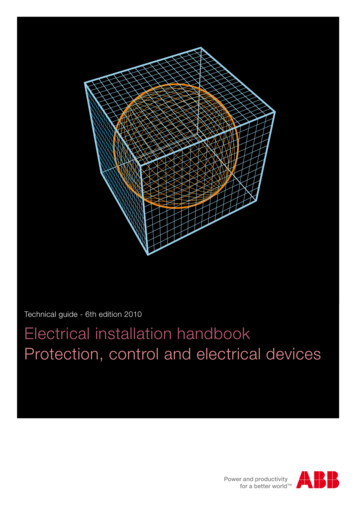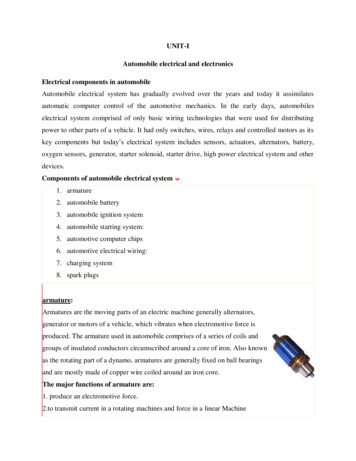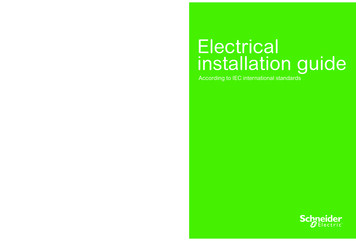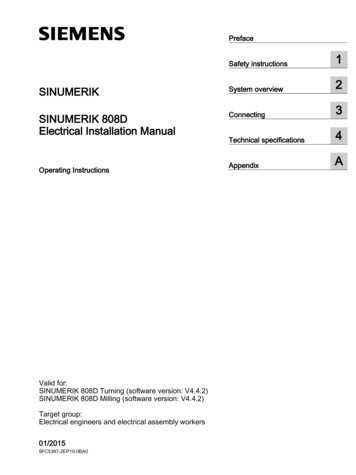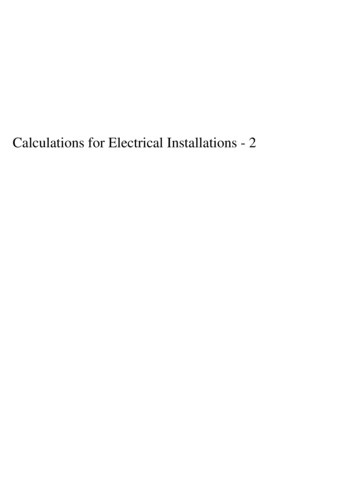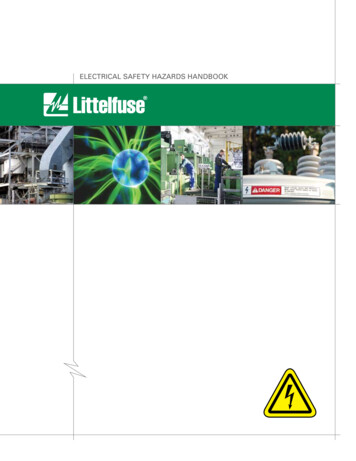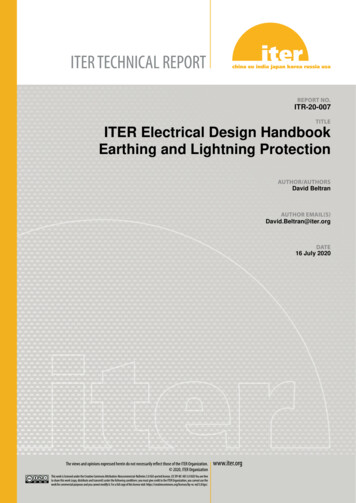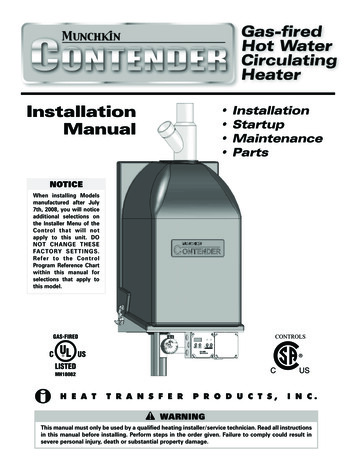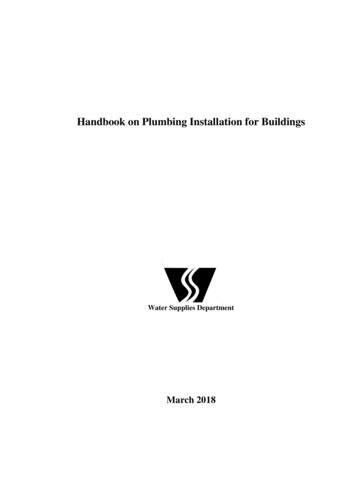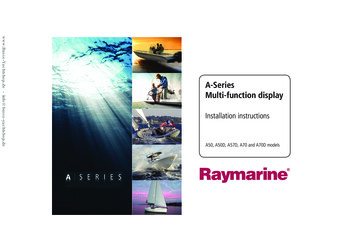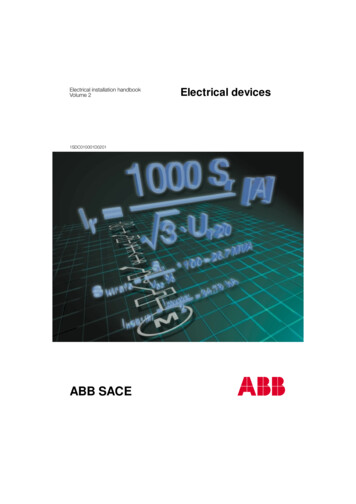
Transcription
Electrical installation handbookVolume 21SDC010001D0201ABB SACEElectrical devices
IndexIntroduction . 21 Standards1.1 General aspects . 31.2 IEC Standards for electrical installation . 152 Protection of feeders2.1 Introduction . 222.2 Installation and dimensioning of cables . 252.2.1 Current carrying capacity and methods of installation . 252.2.2 Voltage drop . 542.2.3 Joule-effect losses . 642.3 Protection against overload . 652.4 Protection against short-circuit . 682.5 Neutral and protective conductors . 762.6 Busbar trunking systems . 843 Protection of electrical equipment3.1 Protection and switching of lighting circuits . 993.2 Protection and switching of generators . 1083.3 Protection and switching of motors . 1133.4 Protection and switching of transformers . 1314 Power factor correction4.1 General aspects . 1464.2 Power factor correction method . 1524.3 Circuit-breakers for the protection andswiching of capacitor banks . 1595 Protection of human beings5.1 General aspects: effects of current on human beings . 1625.2 Distribution systems . 1655.3 Protection against both direct and indirect contact . 1685.4 TT system . 1715.5 TN system . 1745.6 IT system . 1775.7 Residual current devices . 1795.8 Maximum protected length for the protection of human beings . 182Annex A: Calculation toolsA.1 Slide rules . 198A.2 DOCWin . 204Annex B: Calculation of load current Ib . 208Annex C: Calculation of short-circuit current . 212Annex D: Calculation of the coefficient k for the cables . 226ABB SACE - Electrical devices1
Introduction1 StandardsScope and objectives1.1 General aspectsIn each technical field, and in particular in the electrical sector, a conditionsufficient (even if not necessary) for the realization of plants according to the“status of the art” and a requirement essential to properly meet the demandsof customers and of the community, is the respect of all the relevant laws andtechnical standards.Therefore, a precise knowledge of the standards is the fundamental premisefor a correct approach to the problems of the electrical plants which shall bedesigned in order to guarantee that “acceptable safety level” which is neverabsolute.The scope of this electrical installation handbook is to provide the designer anduser of electrical plants with a quick reference, immediate-use working tool.This is not intended to be a theoretical document, nor a technical catalogue,but, in addition to the latter, aims to be of help in the correct definition ofequipment, in numerous practical installation situations.The dimensioning of an electrical plant requires knowledge of different factorsrelating to, for example, installation utilities, the electrical conductors and othercomponents; this knowledge leads the design engineer to consult numerousdocuments and technical catalogues. This electrical installation handbook,however, aims to supply, in a single document, tables for the quick definition ofthe main parameters of the components of an electrical plant and for the selectionof the protection devices for a wide range of installations. Some applicationexamples are included to aid comprehension of the selection tables.Juridical StandardsThese are all the standards from which derive rules of behavior for the juridicalpersons who are under the sovereignty of that State.Electrical installation handbook usersTechnical StandardsThese standards are the whole of the prescriptions on the basis of whichmachines, apparatus, materials and the installations should be designed,manufactured and tested so that efficiency and function safety are ensured.The technical standards, published by national and international bodies, arecircumstantially drawn up and can have legal force when this is attributed by alegislative measure.The electrical installation handbook is a tool which is suitable for all those whoare interested in electrical plants: useful for installers and maintenance techniciansthrough brief yet important electrotechnical references, and for sales engineersthrough quick reference selection tables.Validity of the electrical installation handbookSome tables show approximate values due to the generalization of the selectionprocess, for example those regarding the constructional characteristics ofelectrical machinery. In every case, where possible, correction factors are givenfor actual conditions which may differ from the assumed ones. The tables arealways drawn up conservatively, in favour of safety; for more accuratecalculations, the use of DOCWin software is recommended for the dimensioningof electrical installations.Application fieldsElectrotechnics andElectronicsInternational BodyEuropean BodyTelecommunicationsMechanics, Ergonomicsand SafetyIECITUISOCENELECETSICENThis technical collection takes into consideration only the bodies dealing with electrical and electronictechnologies.IEC International Electrotechnical CommissionThe International Electrotechnical Commission (IEC) was officially founded in1906, with the aim of securing the international co-operation as regardsstandardization and certification in electrical and electronic technologies. Thisassociation is formed by the International Committees of over 40 countries allover the world.The IEC publishes international standards, technical guides and reports whichare the bases or, in any case, a reference of utmost importance for any nationaland European standardization activity.IEC Standards are generally issued in two languages: English and French.In 1991 the IEC has ratified co-operation agreements with CENELEC (Europeanstandardization body), for a common planning of new standardization activitiesand for parallel voting on standard drafts.ABB SACE - Electrical devices2ABB SACE - Electrical devices3
1.1 General aspects1.1 General aspects1 Standards1 StandardsCENELEC European Committee for Electrotechnical Standardization“Low Voltage” Directive 73/23/CEE – 93/68/CEEThe European Committee for Electrotechnical Standardization (CENELEC) wasset up in 1973. Presently it comprises 22 countries (Austria, Belgium, CzechRepublic, Denmark, Finland, France, Germany, Greece, Hungary, Iceland,Ireland, Italy, Luxembourg, Malta, Netherlands, Norway, Portugal, Slovakia,Spain, Sweden, Switzerland, United Kingdom) and cooperates with 13 affiliates(Albania, Bosnia and Herzegovina, Bulgaria, Croatia, Cyprus, Estonia, Latvia,Lithuania, Poland, Romania, Slovenia, Turkey, Ukraine) which have firstmaintained the national documents side by side with the CENELEC ones andthen replaced them with the Harmonized Documents (HD).There is a difference between EN Standards and Harmonization Documents(HD): while the first ones have to be accepted at any level and without additionsor modifications in the different countries, the second ones can be amended tomeet particular national requirements.EN Standards are generally issued in three languages: English, French andGerman.From 1991 CENELEC cooperates with the IEC to accelerate the standardspreparation process of International Standards.CENELEC deals with specific subjects, for which standardization is urgentlyrequired.When the study of a specific subject has already been started by the IEC, theEuropean standardization body (CENELEC) can decide to accept or, whenevernecessary, to amend the works already approved by the Internationalstandardization body.The Low Voltage Directive refers to any electrical equipment designed for useat a rated voltage from 50 to 1000 V for alternating current and from 75 to 1500 V fordirect current.In particular, it is applicable to any apparatus used for production, conversion,transmission, distribution and use of electrical power, such as machines,transformers, devices, measuring instruments, protection devices and wiringmaterials.The following categories are outside the scope of this Directive: electrical equipment for use in an explosive atmosphere; electrical equipment for radiology and medical purposes; electrical parts for goods and passenger lifts; electrical energy meters; plugs and socket outlets for domestic use; electric fence controllers; radio-electrical interference; specialized electrical equipment, for use on ships, aircraft or railways, whichcomplies with the safety provisions drawn up by international bodies in whichthe Member States participate.EC DIRECTIVES FOR ELECTRICAL EQUIPMENTAmong its institutional roles, the European Community has the task ofpromulgating directives which must be adopted by the different member statesand then transposed into national law.Once adopted, these directives come into juridical force and become a referencefor manufacturers, installers, and dealers who must fulfill the duties prescribedby law.Directives are based on the following principles: harmonization is limited to essential requirements; only the products which comply with the essential requirements specified bythe directives can be marketed and put into service; the harmonized standards, whose reference numbers are published in theOfficial Journal of the European Communities and which are transposed intothe national standards, are considered in compliance with the essentialrequirements; the applicability of the harmonized standards or of other technical specificationsis facultative and manufacturers are free to choose other technical solutionswhich ensure compliance with the essential requirements; a manufacturer can choose among the different conformity evaluation procedure provided by the applicable directive.The scope of each directive is to make manufacturers take all the necessarysteps and measures so that the product does not affect the safety and healthof persons, animals and property.ABB SACE - Electrical devices4Directive EMC 89/336/EEC (“Electromagnetic Compatibility”)The Directive on electromagnetic compatibility regards all the electrical andelectronic apparatus as well as systems and installations containing electricaland/or electronic components. In particular, the apparatus covered by thisDirective are divided into the following categories according to theircharacteristics: domestic radio and TV receivers; industrial manufacturing equipment; mobile radio equipment; mobile radio and commercial radio telephone equipment; medical and scientific apparatus; information technology equipment (ITE); domestic appliances and household electronic equipment; aeronautical and marine radio apparatus; educational electronic equipment; telecommunications networks and apparatus; radio and television broadcast transmitters; lights and fluorescent lamps.The apparatus shall be so constructed that:a) the electromagnetic disturbance it generates does not exceed a level allowingradio and telecommunications equipment and other apparatus to operateas intended;b) the apparatus has an adequate level of intrinsic immunity to electromagneticdisturbance to enable it to operate as intended.An apparatus is declared in conformity to the provisions at points a) and b)when the apparatus complies with the harmonized standards relevant to itsproduct family or, in case there aren’t any, with the general standards.ABB SACE - Electrical devices5
1.1 General aspects1.1 General aspects1 Standards1 StandardsCE conformity markingABB SACE circuit-breakers (Isomax-Tmax-Emax) are approved by the followingshipping registers:The CE conformity marking shall indicate conformity to all the obligationsimposed on the manufacturer, as regards his products, by virtue of the EuropeanCommunity directives providing for the affixing of the CE marking. When the CE marking is affixed on a product, it represents a declaration of themanufacturer or of his authorized representative that the product in questionconforms to all the applicable provisions including the conformity assessmentprocedures. This prevents the Member States from limiting the marketing andputting into service of products bearing the CE marking, unless this measure isjustified by the proved non-conformity of the product.The manufacturerdraw up the technicaldocumentationcovering the design,manufacture andoperation of theproductThe manufacturerguarantees and declaresthat his products are inconformity to the technicaldocumentation and to thedirective requirementsThe international and national marks of conformity are reported in the followingtable, for information only:COUNTRYMark ��Mark of compliance with theharmonized European standardslisted in the ENEC Agreement.AUSTRALIAAS MarkElectrical and non-electricalproducts.It guarantees compliance withSAA (Standard Association ofAustralia).AUSTRALIAS.A.A. MarkStandards Association ofAustralia (S.A.A.).The Electricity Authority of NewSouth Wales Sydney AustraliaAUSTRIAAustrian Test MarkInstallation equipment andmaterialsNaval type approvalThe environmental conditions which characterize the use of circuit breakers foron-board installations can be different from the service conditions in standardindustrial environments; as a matter of fact, marine applications can requireinstallation under particular conditions, such as:- environments characterized by high temperature and humidity, including saltmist atmosphere (damp-heat, salt-mist environment);- on board environments (engine room) where the apparatus operate in thepresence of vibrations characterized by considerable amplitude and duration.In order to ensure the proper function in such environments, the shippingregisters require that the apparatus has to be tested according to specific typeapproval tests, the most significant of which are vibration, dynamic inclination,humidity and dry-heat tests.ABB SACE - Electrical devicesItalian shipping registerNorwegian shipping registerFrench shipping registerGerman shipping registerBritish shipping registerAmerican shipping registerMarks of conformity to the relevant national andinternational StandardsASDC008045F0201ManufacturerEC declaration ofconformityRegistro Italiano NavaleDet Norske VeritasBureau VeritasGermanischer LloydLloyd’s Register of ShippingAmerican Bureau of ShippingIt is always advisable to ask ABB SACE as regards the typologies and theperformances of the certified circuit-breakers or to consult the section certificatesin the website http://bol.it.abb.com.Flow diagram for the conformity assessment procedures established by the Directive73/23/EEC on electrical equipment designed for use within particular voltage range:Technical fileRINADNVBVGLLRsABS6OVEABB SACE - Electrical devices7
1.1 General aspects1.1 General aspects1 StandardsCOUNTRYSymbol1 StandardsMark designationApplicability/OrganizationCOUNTRYMark designationApplicability/OrganizationAUSTRIAÖVE IdentificationThreadCablesCROATIAKONKARElectrical Engineering InstituteBELGIUMCEBEC MarkInstallation materials and electricalappliancesDENMARKDEMKOApproval MarkLow voltage materials.This mark guarantees thecompliance of the product withthe requirements (safety) of the“Heavy Current Regulations”BELGIUMCEBEC MarkConduits and ducts, conductorsand flexible cordsFINLANDSafety Markof the ElektriskaInspektoratetLow voltage material.This mark guarantees thecompliance of the product withthe requirements (safety) of the“Heavy Current Regulations”Certification ofConformityInstallation material and electricalappliances (in case there are noequivalent national standards orcriteria)FRANCEESC MarkHousehold appliancesBELGIUMCSA MarkElectrical and non-electricalproducts.This mark guarantees compliancewith CSA (Canadian StandardAssociation)FRANCENF MarkConductors and cables –Conduits and ducting –Installation materialsCCEE MarkGreat Wall Mark Commission forCertification of ElectricalEquipmentFRANCENF IdentificationThreadCablesEZU’ MarkElectrotechnical Testing InstituteFRANCENF MarkPortable motor-operated toolsElectrotechnical Research andDesign InstituteFRANCENF MarkHousehold appliancesEVPU’ MarkCANADACHINASymbolCzech RepublicSlovakiaRepublicABB SACE - Electrical devices8ABB SACE - Electrical devices9
1.1 General aspects1.1 General aspects1 StandardsCOUNTRYSymbolGERMANYGERMANYGERMANY1 StandardsMark designationApplicability/OrganizationCOUNTRYVDE MarkFor appliances and technicalequipment, installation accessoriessuch as plugs, sockets, fuses,wires and cables, as well as othercomponents (capacitors, earthingsystems, lamp holders andelectronic devices)ITALYVDEIdentification ThreadCables and cordsVDE Cable MarkFor cables, insulated cords,installation conduits and ductsSymbolMark designationIMQ MarkNORWAYNorwegian ApprovalMarkApplicability/OrganizationMark to be affixed on electricalmaterial for non-skilled users; itcertifies compliance with theEuropean Standard(s).Mandatory safety approval for lowvoltage material and equipmentGeneral for all equipmentNETHERLANDSKEMA-KEURKEURVDE-GS Markfor YPOLANDElectrical productsSINGAPORESINGAPODASLOVENIAIRELANDIIRS MarkElectrical equipmentSPAINFOARMCO N FIIRS MarkOSPAINElectrical equipmentTYMARMIKRElectrical and non-electricalproductsSIQSlovenian Institute of Quality andMetrologyR M I DA D AAEEElectrical products.The mark is under the control ofthe Asociación ElectrotécnicaEspañola(Spanish ElectrotechnicalAssociation)AENORAsociación Española deNormalización y Certificación.(Spanish Standarization andCertification Association)R MA S U NOFSISIRNOC A DE CONMark which guaranteescompliance with the relevantJapanese Industrial Standard(s).EJIS MarkRSTA N D ARPPOEJAPANIRELANDKWEBR O V ED TMEEISafety mark for technical equipmentto be affixed after the product hasbeen tested and certified by the VDETest Laboratory in Offenbach; theconformity mark is the mark VDE,which is granted both to be usedalone as well as in combination withthe mark GSHungarian Institute for Testing andCertification of Electrical EquipmentI . I. R . S .ABB SACE - Electrical devices10ABB SACE - Electrical devices11
1.1 General aspects1.1 General aspectsUNITEDKINGDOMSWITZERLANDSafety MarkSwiss low voltage material subjectto mandatory approval (safety).UNITEDKINGDOMSWITZERLAND–Cables subject to mandatoryapprovalU.S.A.TOB R IT I SHANDTESTINGMark designationApplicability/OrganizationBSISafety MarkCompliance with the “BritishStandards”BEABKitemarkCompliance with the relevant“British Standards” regardingsafety and performancesUNDERWRITERSLABORATORIESMarkElectrical and non-electricalproductsDENT LA BORENAN IEPYMandatory safety approval for lowvoltage material and licability/OrganizationA N D ARSTMark designationROVEDSymbolPPCOUNTRY1 StandardsD1 StandardsFOR P U B L ICSL I S T E D(Product Name)(Control Number)Low voltage material subject tomandatory al and non-electricalproductsUNITEDKINGDOMASTA MarkMark which guaranteescompliance with the relevant“British Standards”U.S.A.UL RecognitionElectrical and non-electricalproductsUNITEDKINGDOMBASEC MarkMark which guaranteescompliance with the “BritishStandards” for conductors, cablesand ancillary products.CENCEN MarkMark issued by the EuropeanCommittee for Standardization(CEN): it guarantees compliancewith the European Standards.UNITEDKINGDOMBASECIdentification ty MarkCompliance with the “BritishStandards” for householdappliancesCENELECHarmonization MarkCertification mark providingassurance that the harmonizedcable complies with the relevantharmonized CENELEC Standards– identification threadKARMABB SACE - Electrical devicesCERTIFICATIONSEV Safety MarkEADTRSWITZERLAND12ABB SACE - Electrical devices13
1.1 General aspects1 StandardsCOUNTRYSymbol1 StandardsMark designationECEx EUROPEA MarkCEEelCEEel Mark1.2 IEC Standards for rk assuring the compliancewith the relevant EuropeanStandards of the products to beused in environments withexplosion hazardsMark which is applicable to somehousehold appliances (shavers,electric clocks, etc).STANDARDYEARTITLEIEC 60027-11992Letter symbols to be used in electricaltechnology - Part 1: GeneralIEC 60034-11999IEC 60617-DB-12M2001IEC 61082-11991IEC 61082-21993IEC 61082-31993IEC 61082-41996IEC 60038IEC 60664-119832000IEC 60909-02001IEC 60865-11993IEC 607811989IEC 60076-1IEC 60076-220001993IEC 60076-32000IEC 60076-52000IEC/TR 606161978IEC 60726IEC 6044519821999Rotating electrical machines - Part 1:Rating and performanceGraphical symbols for diagrams - 12month subscription to online databasecomprising parts 2 to 11 of IEC 60617Preparation of documents used inelectrotechnology - Part 1: GeneralrequirementsPreparation of documents used inelectrotechnology - Part 2: Functionoriented diagramsPreparation of documents used inelectrotechnology - Part 3: Connectiondiagrams, tables and listsPreparation of documents used inelectrotechnology - Part 4: Location andinstallation documentsIEC standard voltagesInsulation coordination for equipmentwithin low-voltage systems - Part 1:Principles, requirements and testsShort-circuit currents in three-phase a.c.systems - Part 0: Calculation of currentsShort-circuit currents - Calculation ofeffects - Part 1: Definitions andcalculation methodsApplication guide for calculation of shortcircuit currents in low-voltage radialsystemsPower transformers - Part 1: GeneralPower transformers - Part 2: TemperaturerisePower transformers - Part 3: Insulationlevels, dielectric tests and externalclearances in airPower transformers - Part 5: Ability towithstand short circuitTerminal and tapping markings for powertransformersDry-type power transformersBasic and safety principles for manmachine interface, marking andidentification - Identification ofequipment terminals and of terminationsof certain designated conductors,including general rules for analphanumeric systemEC - Declaration of ConformityThe EC Declaration of Conformity is the statement of the manufacturer, whodeclares under his own responsibility that all the equipment, procedures orservices refer and comply with specific standards (directives) or other normativedocuments.The EC Declaration of Conformity should contain the following information: name and address of the manufacturer or by its European representative; description of the product; reference to the harmonized standards and directives involved; any reference to the technical specifications of conformity; the two last digits of the year of affixing of the CE marking; identification of the signer.A copy of the EC Declaration of Conformity shall be kept by the manufactureror by his representative together with the technical documentation.ABB SACE - Electrical devices14ABB SACE - Electrical devices15
1.2 IEC Standards for electrical installation1.2 IEC Standards for electrical installation1 Standards1 StandardsSTANDARDYEARTITLESTANDARDYEARTITLEIEC 600731996IEC 60947-5-61999IEC 604461999IEC 60947-6-11998Low-voltage switchgear and controlgear Part 5-6: Control circuit devices andswitching elements – DC interface forproximity sensors and switchingamplifiers (NAMUR)Low-voltage switchgear and controlgear Part 6-1: Multiple function equipment –Automatic transfer switching equipmentIEC 604471993IEC 60947-6-21999IEC 60947-12001IEC 60947-22001IEC 60947-7-11999IEC 60947-32001Basic and safety principles for manmachine interface, marking andidentification – Coding for indicationdevices and actuatorsBasic and safety principles for manmachine interface, marking andidentification - Identification ofconductors by colours or numeralsMan-machine-interface (MMI) - ActuatingprinciplesLow-voltage switchgear and controlgear Part 1: General rulesLow-voltage switchgear and controlgear Part 2: Circuit-breakersLow-voltage switchgear and controlgear Part 3: Switches, disconnectors, switchdisconnectors and fuse-combinationunitsLow-voltage switchgear and controlgear Part 4-1: Contactors and motor-starters –Electromechanical contactors and motorstartersLow-voltage switchgear and controlgear Part 4-2: Contactors and motor-starters –AC semiconductor motor controllers andstartersLow-voltage switchgear and controlgear Part 4-3: Contactors and motor-starters –AC semiconductor controllers andcontactors for non-motor loadsLow-voltage switchgear and controlgear Part 5-1: Control circuit devices andswitching elements - Electromechanicalcontrol circuit devicesLow-voltage switchgear and controlgear Part 5-2: Control circuit devices andswitching elements – Proximity switchesLow-voltage switchgear and controlgear Part 5-3: Control circuit devices andswitching elements – Requirements forproximity devices with defined behaviourunder fault conditionsLow-voltage switchgear and controlgear Part 5: Control circuit devices andswitching elements – Section 4: Methodof assessing the performance of lowenergy contacts. Special testsLow-voltage switchgear and controlgear Part 5-5: Control circuit devices andswitching elements - Electricalemergency stop device with mechanicallatching functionIEC 60947-7-21995IEC 60439-11999IEC 60439-22000IEC 60439-32001IEC 60439-41999IEC 60439-51999IEC 610952000IEC 60947-4-12000IEC 60947-4-22002IEC 60947-4-31999IEC 60947-5-12000IEC 60947-5-21999IEC 60947-5-31999IEC 60947-5-4IEC 60947-5-5ABB SACE - Electrical devices1996199716ABB SACE - Electrical devicesLow-voltage switchgear and controlgear Part 6-2: Multiple function equipment Control and protective switching devices(or equipment) (CPS)Low-voltage switchgear and controlgear Part 7: Ancillary equipment - Section 1:Terminal blocksLow-voltage switchgear and controlgear Part 7: Ancillary equipment - Section 2:Protective conductor terminal blocks forcopper conductorsLow-voltage switchgear and controlgearassemblies - Part 1: Type-tested andpartially type-tested assembliesLow-voltage switchgear and controlgearassemblies - Part 2: Particularrequirements for busbar trunking systems(busways)Low-voltage switchgear and controlgearassemblies - Part 3: Particularrequirements for low-voltage switchgearand controlgear assemblies intended tobe installed in places where unskilledpersons have access for their use Distribution boardsLow-voltage switchgear and controlgearassemblies - Part 3: Particularrequirements for low-voltage switchgearand controlgear assemblies intended tobe installed in places where unskilledpersons have access for their use Distribution boardsLow-voltage switchgear and controlgearassemblies - Part 3: Particularrequirements for low-voltage switchgearand controlgear assemblies intended tobe installed in places where unskilledpersons have access for their use Distribution boardsLow-voltage switchgear and controlgearassemblies - Part 3: Particularrequirements for low-voltage switchgearand controlgear assemblies intended tobe installed in places where unskilledpersons have access for their use Distribution boards17
1.2 IEC Standards for electrical installation1.2 IEC Standards for electrical installation1 Standards1 StandardsSTANDARDYEARTITLEIEC 608901987IEC 611171992IEC 60092-3031980IEC 60092-3011980IEC 60092-1011994IEC 60092-4011980IEC 60092-2011994IEC 60092-2021994IEC 60092-3021997IEC 60092-3502001IEC 60092-3521997IEC 60364-5-522001A method of temperature-rise assessmentby extrapolation for partially type-testedassemblies (PTTA) of low-voltageswitchgear and controlgearA method for assessing the short-circuitwithstand strength of partially type-testedassemblies (PTTA)Electrical installations in ships. Part 303:Equipment - Transformers for power andlightingElectrical installations in ships. Part 301:Equipment - Generators and motorsElectrical installations in ships - Part 101:Definitions and general requirementsElectrical installations in ships. Part 401:Installation and test of completedinstallationElectrical installations in ships - Part 201:System design - GeneralElectrical installations in ships - Part 202:System design - ProtectionElectrical installations in ships - Part 302:Low-voltage switchgear and controlgearassembliesElectrical installations in ships - Part 350:Shipboard power cables - Generalconstruction and test requirementsElectrical installations in ships - Part 352:Choice and installation of cables for lowvoltage power systemsElectrical installations of buildings - Part5-52: Selection and erection of electricalequipment – Wiring systemsPolyvinyl chloride insulated cables ofrated v
Electrical installation handbook users The electrical installation handbook is a tool which is suitable for all those who are interested in electrical plants: useful for installers and maintenance technicians through brief yet important electrotechnical references, and for sales engineers through quick reference selection tables.
